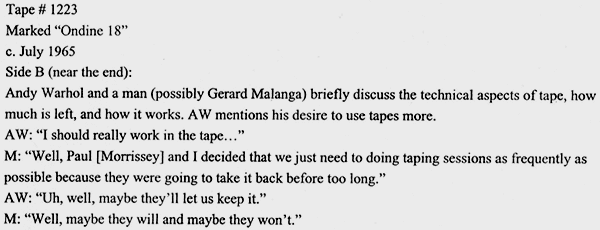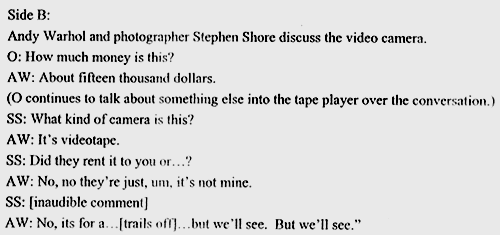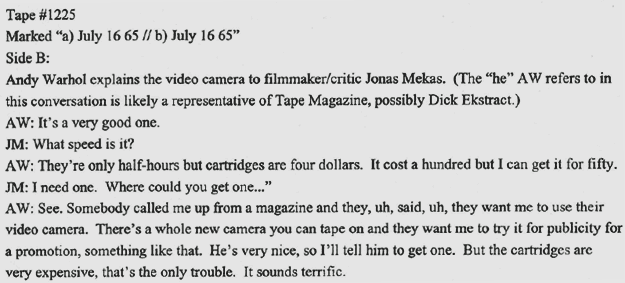What Andy Warhol Didn't Do cont.
4. TRANSCRIPTS AND FORGERIES
1. What Happened? | 2. Bruno B. | 3. Why? | 4. Transcripts and Forgeries | 5. Addendum: Richard Dorment and the New York Review of Books | 6. Addendum #2: Response to Richard Dorment
The transcripts of tape-recorded conversations between Warhol and his colleagues discussing the Norelco equipment can be found on Joe Simon-Whelan's website.
Here is one of the transcripts:

The equipment is mentioned and the possibility that "maybe they'll let us keep it," but nowhere does Warhol suggest creating a new set of Self-Portraits and trading them for a loan or an extension of a loan of the equipment.
Here is another transcript:

In the above conversation between Stephen Shore and Warhol, there is no mention of the Self-Portraits or exchanging paintings for the equipment. All we have is Andy Warhol giving a noncommittal "we'll see." He or his representative could have been asking for an extension of the equipment as part of their endorsement deal. As Paul Morrissey put it "you get the Norelco if you pose for a picture with it for a magazine." (JSW14)
There is an explanatory note following the transcripts which does draw a connection between the equipment and the Self-Portraits but that note is by Joe Simon-Whelan who has a vested interest in the case. It is his interpretation of what is said on the tapes and not what the people on the tapes actually said.
Joe Simon-Whelan:
On these tapes Warhol is discussing Ekstract and his video camera with Paul Morrissey, Ondine, Gerard Malanga, Stephen Shore and Jonas Mekas.
In reality, none of the transcripts mention Richard Ekstract by name and there are no conversations that include Paul Morrissey. Joe Simon-Whelan continues:
Joe Simon-Whelan:
Andy indicates a strong desire to keep the video camera past the amount of time he was suppose to borrow it for, plus get the $100 dollar video cartridges for free. He said that he was going to speak with 'Dick' to arrange something... Andy and Paul Morrissey repeatedly called Richard Ekstract until a deal was worked out. I have a letter from Paul Morrissey which documents this. Paul Morrissey says that Andy was trading what Warhol saw as nothing for something...
Mr. Simon-Whelan says that he has a letter from Paul Morrissey which documents the fact that "Andy and Paul Morrissey called Richard Ekstract until a deal was worked out." Where is that letter? That's not what Paul Morrissey said in his November 1, 2002 letter. And it's certainly not what Paul Morrissey said in his deposition.
Mr. Simon-Whelan says that in the transcripts "he [Warhol] said that he was going to speak with 'Dick' to arrange something..." Where does Warhol say that? None of the transcripts that Mr. Simon-Whelan has posted mention "Dick." The only time "Dick" is mentioned is in parentheses, as a note added later which is not part of the transcribed conversation:

In the above transcript Andy Warhol says that somebody from a magazine rang and wanted him to use their video camera "for publicity, for a promotion, something like that." They were effectively asking him to endorse a product that they were promoting. This agrees with the version of events offered in POPism as quoted previously.
There is no mention of an exchange of Self-Portraits on the tapes. Nor are the Self-Portraits ever referred to in interviews with Warhol or in Warhol's diaries. The diaries do, however, document Warhol's concern with forgeries of his work in general. The following are just a few of the entries dealing with forgeries:
Andy Warhol (Sunday, 11 June 1978):
Went to church, got magazines... and went to the office... because Rupert was bringing by the Flower things. I decided I won't sign the fake ones that're turning up all over Europe... Maybe I should do new ones and make good on the fakes in Europe. I don't know, I'll see." (AWD142)
Andy Warhol (Tuesday, 12 March 1985):
Went up to [name withheld] to look at the art and the lady there stopped me and asked if I had a few minutes to look at a few paintings of mine for authenticity, so I did, and one of them was on of those fake Electric Chairs, the one [name withheld] denies doing. A blue one. It wasn't stretched right. The people get greedy and they want a bigger picture, so it's got a border on it. They'd buy it rolled and then stretch it that way." (AWD631)
Andy Warhol: (Friday, 14 November 1986):
"Julian Schnabel came by with his little girl. We're talking about me maybe doing some different image on top of a fake of mine that he bought... Julian didn't know it was a fake when he bought it." (AWD774)
And there is even an entry that refers to fake Self-Portraits:
Andy Warhol (Sunday, August 3, 1986):
"Went to church and it was just organ music, and then went to 26th Street to the flea market and while I was there I verified a fake - that a fake was a fake. It was a portrait of me, actually a good copy. They did a good job, they just didn't frame it right and some of the cotton canvas with the white was showing." (AWD750)
Richard Dorment tries to explain away this fake Self-Portrait by writing, "...by this date Warhol was not only the most famous artist in the US, but also one of the best-known faces. The idea that a picture from the series (which were sold by both major auction houses and handled by respected art dealers) was of such low quality that it ended up unrecognised in a flea market is bizarre. What is more, Warhol would have recognized a Red Self Portrait [Norgus Self-Portrait] instantly—he did, after all, exhibit the pictures in the series at the party Ekstract gave on September 29, 1965." (JSW9n.9)
But that is exactly the point. Lacking the hand-painting of the 1964 Self-Portraits, the Norgus Self-Portraits were more like posters than paintings - exactly what would be included in a flea market. Saying that Warhol would recognize a Norgus Self Portrait because the series was exhibited at the party presupposes that Warhol was aware of the Norgus Self Portraits in the first place and that they were, in fact, exhibited at the party. Dorment says that pictures from the series "were sold by both major auction houses," but he neglects to mention that they were not sold until after Warhol's death.
In addition to the lack of documentary evidence and the confusion regarding the reasons that the Norgus Self-Portraits were created in the first place, there are also the technical differences between the Norgus series and Warhol's oeuvre in general. Those differences are clearly stated in a letter that the Authentication Board sent to Richard Ekstract in 2004 when he submitted his Norgus Self-Portrait to them:
1. The series of Self-Portraits that Andy Warhol made in early 1964 consists of a group of works of the same size, produced from the same photographic source. Eleven works of this type have been documented by the editors of the Andy Warhol Catalogue Raisonné thus far. Each work in this series is different from all the others as noted below. This is not the case with respect to the work you submitted to the Andy Warhol Authentication Board.
To date, ten paintings have been examined by the Andy Warhol Art Authentication Board that are identical to each other and to the work you submitted. The existence of ten identical works is without precedent in the corpus of Warhol's paintings.
2. The background of the Self-Portraits that Andy Warhol made in early 1964 is painted by hand; and each background has been painted a different color. The background of the painting you submitted and the backgrounds of the nine identical examples are printed, not hand-painted.
3. The eyes, skin tones, and the silver hair in the Self-Portraits that Andy Warhol made in early 1964 are hand-painted; the color of the eyes varies from work to work. The eyes, skin tones, and hair in the work you submitted and in the nine identical examples are printed, not hand-painted.
4. The only aspect of the Self-Portraits that Warhol made in early 1964 that is printed is the black silkscreen impression, printed over the areas of hand-painted color. Each impression varies among the works made by Warhol, as does the registration of the black screen over the ares of hand-painted color. This is not the case with respect to the work you submitted and the nine identical examples.
5. Warhol's Self-Portraits of early 1964 were all made on linen. The work you submitted and the nine identical examples were made on cotton.
6. Warhol's Self-Portraits were produced from a photograph that he submitted to the silkscreen fabricator with his instructions on a paste-up mechanical. The photograph in the mechanical was reproduced by the silkscreen fabricator onto a photo-sensitive silkscreen. The silkscreen was used by Warhol to depict the outlines of the head and the features of the face The tones from the photograph seen on the canvas as a pattern of black dots are known as halftone.
The density of the halftone in the work you submitted to our review and in the nine identical examples is reduced, as compared to the density of the halftones on Warhol's early 1964 canvases, indicating the work you submitted and the other nine identical works examined by the Board were not made from the same silkscreen that Warhol used to make this series of work in early 1964.
7. Finally, as part of its research, the Board learned that the work you submitted and all nine identical examples were printed by a commercial printer in 1965. The printer claimed that he received materials and specifications from another party, and had never had any contact with Warhol himself.
The evidence that the Norgus Self-Portraits are not by Warhol far exceeds the largely circumstantial evidence that they are by him. Warhol was a hoarder but so far not a single piece of paper has been found in Warhol's archives which refers to the series. The reason for the series in the first place seems confused. Were they done in order to pay for an extension of equipment? Or were they created to pay for publicity and a party? None of the people involved in the alleged deal have given the specifics of any conversations about the alleged deal with Warhol and it is unclear from their statements whether or not their instructions came from Warhol or somebody else. The printer who printed the series admitted that he did not have any contact with Warhol. In regard to publicity and the party, it is clear that the party was timed to coincide with the New York Hi Fidelity Show to hype both Ekstract's magazine and Norelco's equipment. It is highly doubtful that Warhol would have created an entire series of paintings (using a printer he never used for anything else) in order to exchange them for press or a party - particularly given that there is no other instance of him doing so in his lifetime. None of the photographs of the party showed any of the Norgus Self-Portraits.
What was particularly disturbing about this whole saga was that Andy Warhol's oeuvre was being re-defined according to a simplistic theory based on a series of works that he never acknowledged during his lifetime and probably never knew existed. Richard Dorment argued in The New York Review of Books that the Norgus "reproductions" (as they were referred to by Herman Meyer) should be seen as some sort of radical innovation. But Warhol was not into duplication, he was into repetition - but repetition that was not repetitive at all. His Cagean retention of the random errors produced by the silkscreening process and his use of hand-painting on individual canvases meant that his works were both repetitive and variable at the same time. Warhol may have exhibited 32 soup cans for his first pop exhibition in a gallery but each can was a different flavour. Each of his 1964 Self-Portraits used the the same image as its basis, but with different coloured backgrounds. Random "mistakes" which emphasized the differences between the repeated images were retained. Repetition was both desirable and impossible. In the words of Kierkegaard, "I had discovered that there was no such thing as repetition. I became aware of this by having it repeated in every possible way." (SK45)
Gary Comenas, May 2011, November 2023)
to Addendum: Richard Dorment and the New York Review of Books